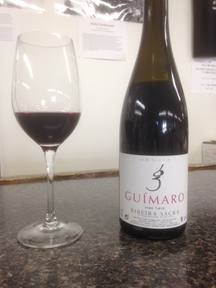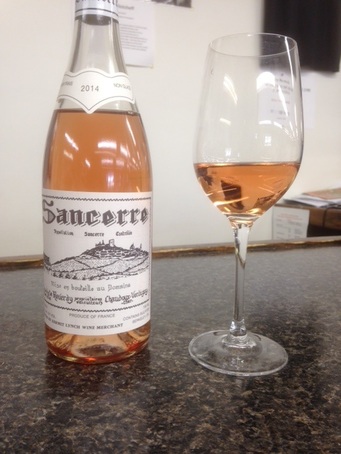 The return of a producer that was considered among the great value wine sources from Nimes and the entire southern region of France. Their success in the late 90s-early 00s helped to open the world's eyes to the potential quality found in regions NOT named Chateauneuf-du-Pape or the other more famous Rhone addresses, and importers have been doing a fantastic job scouring the garrigue covered hills since then for other gems. Mourgues du Gres is still among the pace-setters, and thanks to one of our great local importers is back in our local market. While this is one of their more distinctive single vineyard cuvees, be sure to look for their great value wines in some of the other Wine Warehouse tastings and activities in the near future. The vineyard name 'Terre de Feu' means 'Land Of Fire' and received it's name back in 2003 when the exceptionally hot vintage helped to spark a fire in the surrounding garrigue, causing some scorching on some of the vines. The old vines here usually provided fruit for three of their other blends, but they choose to separate them out, and really came to like the character of the individual site. In subsequent vintages they initially only created this blend when the vintage quality allowed them to hold back the juice without reducing the quality of the other established wines, but as other sites they own have matured and improved, the bottling has become much more consistently produced. A blend of Grenache, Carignan and Syrah, the aromas are immediately warm and inviting, full of red fruits and dried spice, the Carignan providing a particularly savory note. The texture on the palate is fairly rich but not fruity and saturated, with lots of dark earth and unsweetened cocoa notes behind the red fruits, as well as a surprisingly polished finish. This wine exemplifies what has become great about the growth of quality in Southern French wines, that it has much in common with a Cotes du Rhone yet is so distinctive that it deserves to be talked about and enjoyed with its own identity.
0 Comments
 The rebirth of the Mencia grape in Spanish winemaking over the last few decades has marked a great trend of embracing older wines or wine styles and bringing them forward into the 21st century. In much the same way Italy has been proactively replanting and promoting their many (many, many...) less famous local varieties, the successful emergence of Mencia has helped bring more and more attention to the less familiar corners of the country. The grape is prevalent in the region between Old Castile and the Galician provinces, or 'Green Spain', where the terrain is much hillier and cooler. The grape itself is far different than Tempranillo, at one time actually believed to be a genetic predecessor of Cabernet Franc and taken to Bordeaux during Roman expansion. Tests have proved otherwise, but wines like this make it very easy to understand how that connection could have been made. Guimaro and winemaker Pedro Rodriguez take a more neutral, minimalist to their winemaking, and the resulting wine drinks much more like the reds from the Loire than they do from Bordeaux, trading weight and oak barrel aging for vibrancy and freshness. Dusty black cherry aromas with hints of savory herbs and soy, absolutely no signs of heat, perfectly capturing the uniquely cool and lush environment of Ribeira Sacra. On the palate the texture is medium bodied with an impressively polished mouthfeel, almost slippery with extremely fine tannins that show off the savory, gamy fruits. This is a much less 'in your face' style than what most people would expect from a Spanish wine, which is exactly what this wine should be because the grape and the region are unique to the rest of the Iberian Peninsula. INSIDER'S PICK: 2013 FIELD RECORDINGS 'NEVERLAND' CABERNET SAUVIGNON SANTA BARBARA COUNTY $29.993/17/2016  Sometimes the desire to get boundaries drawn for new appellations (also called American Viticultural Areas, or AVA's) can be drawn for political or advertising reasons more-so than the distinction of the wine. More than one of these lines in the world-and yes the French and Italians are just as guilty of this as anyone- have less to do with the distinction of the wine from the land than it does with who owns the land and how much they complained about being included. But the relatively new Happy Canyon AVA in eastern Santa Barbara does in fact make sense, as its more protected by the cooling coastal fog (which helps the Western AVAs in Pinot Noir and Chardonnay production), and the soil is high in magnesium which helps provide more mineral intensity. The region has grown to become a hotbed for Bordeaux styled Sauvignon Blanc and Cabernet Sauvignon in recent years, and as more producers put in vines in the old horse and cattle farms there can only be great things ahead. Field Recordings is the main project from journeyman winemaker Andrew Jones, sourcing grapes from some of the best vineyards in his favored Central Coast region. The Cabernet juice here comes from the Grassini Family vineyard, one of the first and most successful vineyards in Happy Canyon. From the first pour the nose speaks of a serious Cabernet Sauvignon, loaded with dark blackcurrant, cedar, and black pepper notes. With some time open the aroma does develop some hints of warmer red fruits, but as a whole stays very dark and cool. On the palate the fruits stays equally dark, but the tannins are surprisingly well polished, allowing a lot of the cocoa tones to show and even a hint of sweeter dark fruits. The mineral composition in the soil shows through as well on the finish, providing a nice firm acidity that give it a longer and lightly drying finish. A surprisingly high quality Cab for the money that will do extremely well with a much broader selection of foods than just steaks.  Spring is Spring-ing all over the place. Early lowers are in bloom, the first signs of growth are peeking out on the trees, and Daylight Savings Time starts this weekend, robbing us all of that precious extra hour of sleep Sunday morning. While we never really feel that Rose is officially out of season, the fact is they are definitely at their best during warmer weather, and the vast majority of the first new releases start to hit the market over the next 8-10 weeks. So it's time to re-familiarize ourselves with what's out there, perhaps dispel a few more myths along the way. Most Roses are only good through the release of the next vintage, but the great ones can not only survive but even thrive for several years. And this is a great one for sure, from a region that implements vibrancy in every wine that comes from their chalky soils, even the Pinot Noir. From the exceptional stables of importer Kermit Lynch, this wine still holds the same salmon color as it did when it was first bottled, with a noticeable mineral current running under the fresh strawberry and rose petal aromas that is so coveted in the white wines from Sancerre. The winemaking process for the Rose is almost identical to the white wines, and it shows in the texture and vibrant chalky palate. Only the dusty red fruits on the palate and the lingering strawberry leaf flavors through the finish show this wine originated from the Pinot Noir grape and not a white grape. This definitely deserves to be the first chilled wine you drink outside this season.  Time to start taking a look at some Red Burgundy from the 2014 vintage, billed to be a very approachable and youth-oriented vintage which, unless you are searching for items to cellar, is great for the everyday Bourgogne drinker. Several of the last vintages had been inconsistent for value wines because trickier conditions made quality inexpensive juice harder to come by, or they tended to be higher toned in character and a bit less accessible to many drinkers. While those that chase the upper tier of Burgundy may not be as passionate about it, the 2014 vintage looks to be very strong for easy enjoyment and relative value for a change. This is a very recent addition to the Burgundy section, having just been 'discovered' by one of our fine local importers, so it is doubly exciting to break out a wine we have not ever featured before. The family vineyards are in the Cotes de Beaune, centered primarily around Auxey-Duresses, and the organic/biodynamic winemaking style is perfect for creating an early drinking wine like this. A nice ruby color and lots of cool dark cherry aromas that develop some dark spice as it opens up (slowly), juicy at first on the palate but quickly showing the Burgundian earthy underbelly, moving quickly into the tart red fruits as the acidity kicks in. Very polished in texture, there is a lot of 'potential' complexity hiding underneath the fruit that will only come with time; whatever time you come in to taste it today/tomorrow is just a brief snapshot of where this wine will be. It's a wine that still requires some patience, but not as much as Burgundy needs in many years. It deserves to be enjoyed over a long weekend. |
The Best of the Best.We offering free tastings on these wines in the store every Thursday and Friday, and a 10% discount off the retail price through the duration of the day. Come on by and give them a try! Archives
July 2024
Categories |
Location |
|

 RSS Feed
RSS Feed